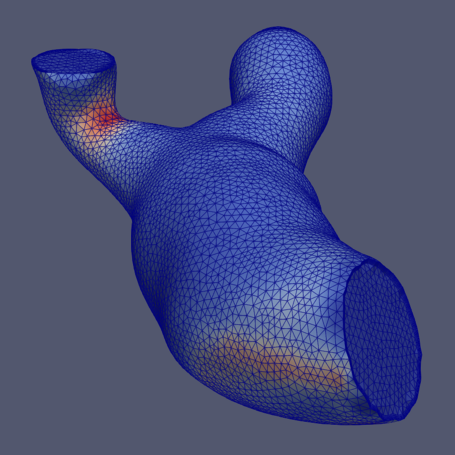Geometric deep learning for personalized medicine
Organization:
Funded by: | |
PhD: | |
Supervisors: | chair MIA: Daily supervisor: |
Collaboration: | - |
Description:
In recent years, artificial intelligence has had a major impact on the automatic analysis of medical image data. However, while a lot of machine learning research has focused on regular 2D or 3D image data, these methods do not generalize to learning from 3D representations extracted from medical images. Recently, geometric deep learning and in particular graph neural networks have emerged as an exciting new direction for machine learning models on such representations.
In this project, we want to expand and apply graph neural networks to learn on 3D shape representations extracted from medical data. We take a new angle at problems in computational science and accelerate the computation of structural dynamics and fluid flow. Since the underlying physical mechanisms of human arteries and organs are well-studied, we also incorporate existing knowledge in our models.
Additionally, we address the question of how deep neural networks and in particular graph neural networks can be described and studied with mathematical rigor. Thereby, we hope to not only find out how deep learning can help in the computational simulation of fluids and solids, but also how the well-established knowledge of numerical analysis can help us design better deep neural networks.
Output:
2024
- Mesh neural networks for SE(3)-equivariant hemodynamics estimation on the artery wall (2024)Computers in biology and medicine, 173. Article 108328. Suk, J., de Haan, P., Lippe, P., Brune, C. & Wolterink, J. M.https://doi.org/10.1016/j.compbiomed.2024.108328
- Generative modeling of living cells with SO(3)-equivariant implicit neural representations (2024)Medical image analysis, 91. Article 102991. Wiesner, D., Suk, J., Dummer, S., Nečasová, T., Ulman, V., Svoboda, D. & Wolterink, J. M.https://doi.org/10.1016/j.media.2023.102991
2023
- SIRE: scale-invariant, rotation-equivariant estimation of artery orientations using graph neural networks (2023)[Working paper › Preprint]. ArXiv.org. Alblas, D., Suk, J. M., Brune, C., Yeung, K. K. & Wolterink, J. M.SE(3)
- Symmetry Lets Graph Neural Networks Learn Arterial Velocity Estimation from Small Datasets (2023)In Functional Imaging and Modeling of the Heart: 12th International Conference, FIMH 2023, Lyon, France, June 19–22, 2023, Proceedings (pp. 445-454). Suk, J., Brune, C. & Wolterink, J. M.https://doi.org/10.1007/978-3-031-35302-4_46
- SE(3) symmetry lets graph neural networks learn arterial velocity estimation from small datasets (2023)[Working paper › Preprint]. ArXiv.org. Suk, J., Brune, C. & Wolterink, J. M.https://doi.org/10.48550/arXiv.2302.08780
2022
- Mesh Neural Networks for SE(3)-Equivariant Hemodynamics Estimation on the Artery Wall (2022)[Working paper › Preprint]. ArXiv.org. Suk, J., de Haan, P., Lippe, P., Brune, C. & Wolterink, J. M.https://doi.org/10.48550/arXiv.2212.05023
- Implicit Neural Representations for Generative Modeling of Living Cell Shapes (2022)In Medical Image Computing and Computer Assisted Intervention – MICCAI 2022: 25th International Conference, Singapore, September 18–22, 2022, Proceedings, Part IV (pp. 58-67) (Lecture Notes in Computer Science; Vol. 13434). Springer. Wiesner, D., Suk, J., Dummer, S., Svoboda, D. & Wolterink, J. M.https://doi.org/10.1007/978-3-031-16440-8_6
- Mesh convolutional neural networks for wall shear stress estimation in 3D artery models (2022)In Statistical Atlases and Computational Models of the Heart. Multi-Disease, Multi-View, and Multi-Center Right Ventricular Segmentation in Cardiac MRI Challenge: 12th International Workshop, STACOM 2021, Held in Conjunction with MICCAI 2021, Strasbourg, France, September 27, 2021, Revised Selected Papers (pp. 93-102). Suk, J. M., de Haan, P., Lippe, P., Brune, C. & Wolterink, J. M.https://doi.org/10.1007/978-3-030-93722-5_11
Pictures:



